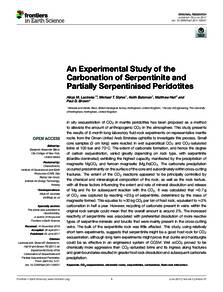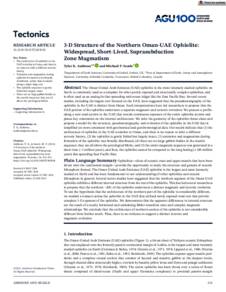Contrasting cooling rates in the lower oceanic crust at fast - and slow - spreading ridges revealed by geospeedometry.
Identifier
DOI: 10.1093/petrology/egm057
Source
Journal of Petrology. Vol. 48, Issue. 11, P. 2211-2231
Contributors
Jenkin, G. R. T., Author
Wilson, R. N. , Author
Country
United Kingdom.
City
Oxford.
Publisher
Oxford University Press.
Gregorian
2007-11-01
Language
English
Subject
English abstract
Two approaches to determining the high-temperature (∼1000°C to ∼600°C) cooling rate of the lower oceanic crust and upper mantle are presented and critically evaluated. The first is based on the down-temperature diffusive exchange of Ca between olivine and clinopyroxene. The second, less well-constrained, approach is based on the down-temperature diffusive exchange of Mg and Fe between olivine and spinel. Cooling rates based on olivine-spinel geospeedometry are approximately an order of magnitude faster than those from Ca-in-olivine geospeedometry. In contrast, cooling rates derived from thermochronology and remanent magnetism are approximately an order of magnitude slower than those derived by Ca-in-olivine geospeedometry; this is probably because they record cooling at lower temperatures. Using the Ca-in-olivine geospeedometer, the cooling rate of samples from the lower oceanic crust and upper oceanic mantle formed in the Oman ophiolite and in the three main ocean basins has been determined. Samples from the lower oceanic crust formed at fast-spreading ridges show a large decrease in cooling rate between the top and base of the gabbroic section, with most of the variation occurring within the upper kilometre. This is consistent with vertical heat loss (within the crustal frame of reference) dominating the thermal evolution at fast-spreading ridges. Samples from Ocean Drilling Program Hole 735B, which formed at the slow-spreading Southwest Indian Ridge, show no variation in cooling rate over 1500 m depth range and cooled substantially faster than rocks from the deeper portion of the gabbros in the Oman ophiolite, where the change in cooling rate with depth is limited. These observations are consistent with heat loss from small plutons emplaced in cool lithosphere at the slow-spreading ridge. Alternatively, they could be explained by cooling through the Ca-in-olivine closure interval during uplift towards the surface.
Description
P 2211-2231.
ISSN
0022-3530
Resource URL
Category
Journal articles




